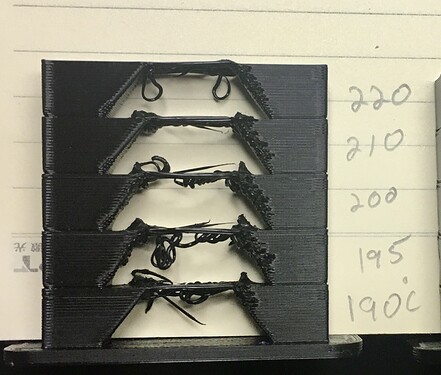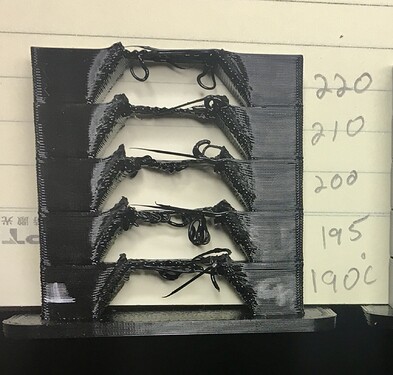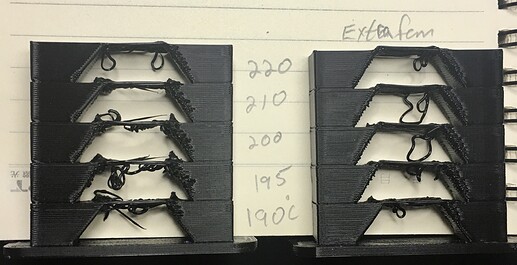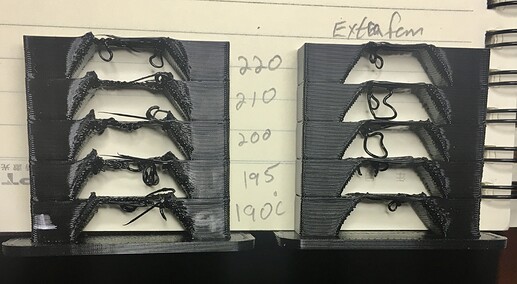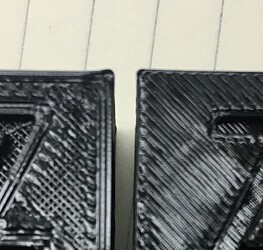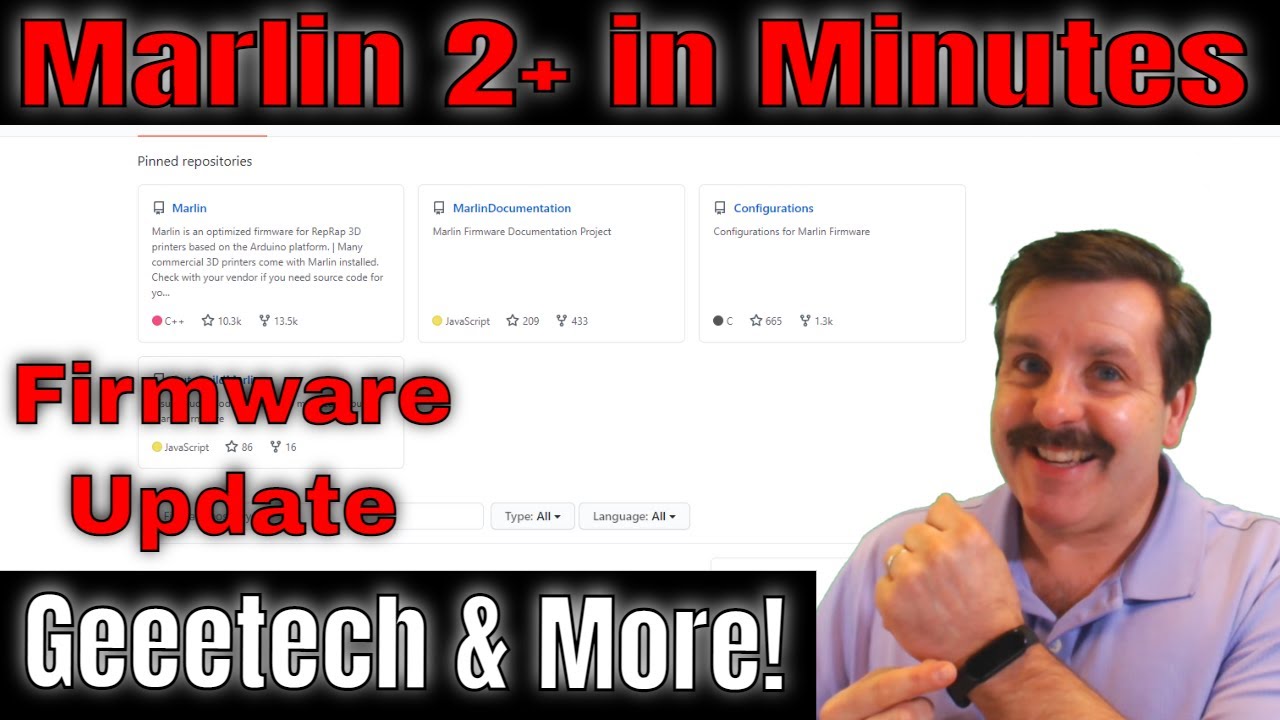Installed the TMC2209s and installed a nice custom firmware for the A10.
Been slowly working on calibrating the printer and playing with parameters. Installed a 4mm glass bed and everything is flat and level.
I’ve been going by this site that @HalfNormal pointed out
Calibrated the E steps, slicer flow, retraction distance and speed. Been working great. Then I get to temp tuning and things get wonky. He’s set up a temp tower that you can enter extruder temps and generate the G code with the site slicer. Had been printing at 200C with the PLA I’m using and it’s seemed to work fine.
This is what the temp tower is suppose to look like.

This is what I got. ![]()
Front side
Back side
Seemed that I might not have enough cooling for the overhangs especially on the back side
Placed a small personal fan behind the printer and repeated the print. Didn’t completely solve the issue but it’s definitely better
Front Sides Comparison
Back Sides Comparison
Any more suggestions? Seems that I might need to add second fan?
Or maybe something like this?
Depending on the brand of pla it’s usually between 200 and 210 for a decent print. I have not personally been able to replicate his Bridges as I end up with something akin to what you get. Unfortunately cooling is a two-way street. Sometimes it’s great and sometimes it’s not and it all depends on the print you’re printing.
Sorry about being ambiguously ambiguous!
Ok glad to know it’s not just me. I suspected there might be something with the way his slicer is setting up the print. He provides the .stl file for the tower but then I would need to figure out how to change temp as a function of print height in Prussia slicer  . Sooo many things to learn.
. Sooo many things to learn. 
First: I don’t concentrate on temperature towers because one of the things I enjoy is working out how to avoid most need for bridges in my designs. When I am designing functional parts, the strength from additional layer adhesion from printing towards the upper end of the range is usually a win for me. I have a used CPAP that I meant to use for remoting cooling and still haven’t gotten around to hooking it up because it turns out it didn’t matter enough to me. However, I’ve read enough to pass on some of what I have learned in case it’s useful.
Most people designing cooling fan ducts (including me) don’t know computational fluid dynamics, and don’t have good intuition for impedance matching in fluid flow. (Air in an open system where all movement is subsonic acts as a fluid system.) Mark Rehorst deleted his reddit account due to all the hate he got merely from saying that you need to test whether you actually get substantial air movement from your cooling setup.
I agree that better cooling looks like it would help. That particular design doesn’t look optimal to me for impedance matching, but this isn’t my area of expertise so you could certainly try it.
But also keep in mind that temperature measurements with thermistors may be more precise than accurate, and temperature specifications for filaments are a wide range. You might try a bit below the recommended range and see what happens to those bridges, including with the extra fan.
If cooling is important to you, there are other things you could try. You could borrow the air pump from your K40 and use latex surgical tubing (the soft stuff) to supply air to a ring something like the one on that part you found. Here are some links that might be useful:
Got Linear Advance enabled in the firmware
![]()
and determined the K value for my filament.
Much sharper corners now.
Feel I got the printer tuned pretty good for now.
Now onto printing real objects. 
First up was a filament arm for the printer I got from thingiverse
Was a two part print and of course the piece that mounted into the frame required a bridge.  Printed that part at 185C and it worked out decently. Just had to do a bit of clean up with a hobby knife and mini file.
Printed that part at 185C and it worked out decently. Just had to do a bit of clean up with a hobby knife and mini file.
After I installed it, I realized that I didn’t have the spool holder bracket shifted as far to the left edge as it could go. Once I did that it seems that the filament arm might not have really been necessary.  No problem though, it’s all still practice for me.
No problem though, it’s all still practice for me. 
That reminds me… I do you have a deburring tool? I waited too long after reading lots of “this changed my life” comments — $12 or so, and you’ll thank yourself the first time you use it, if you are anything like me. I now have one at my mill and another at my 3D printer.
Huh, no I do not have a deburring tool. I’ve seen them for metal use when people are doing lathe work but I hadn’t thought of that for plastic too. Thanks for the tip 
Oh, the ones I’m thinking of aren’t the ones I think of for lathe work. I’m thinking of the swivel-head curved blade units like this:
Ok, yeah that’s the type I was thinking of actually. I meant mill not lathe. 
Ned, you have come a long way! It is very satisfying to fine tune the printer and be able to print reliably. I am glad you are enjoying your journey.
Thanks!  You guys have been a big help in answering my questions.
You guys have been a big help in answering my questions.
Tonight’s adventure in 3d printing involves figuring out how to print with supports. I have very quickly figured out that less is often more when it comes to supports and the ability to remove them afterward. 
Still using PrusaSlicer so I’m going through the knowledgebase figuring out what the parameters mean.
For less-is-more on supports, don’t miss “paint-on supports” to be very specific about where you want supports. 
Too bad oneboxing doesn’t work well in their knowledgebase!
Oh nice, thanks 
Hello; Where can I find the marlin with which you updated your Geeetech A10? greetings
You can download the Marlin source and compile it yourself. You will need to be familiar with your printer specifications to properly configure it.
There are many people who have posted Marlin configs for the Geeetech A10 but you should be careful about using them without knowing the source.
You can also download precompiled marlin firmware directly from the Geeetech website. This is the route I would recommend unless you know what you’re doing.
https://www.geeetech.com/download.html?download_id=30
I recently bought a Geeetech A10 during that recent sale to augment the Mendel90 I built a few years ago. I bought a 3dtouch as an addon and enabling it was as simple as downloading the 3dtouch/bltouch enabled firmware direct from Geeetech and installing it.
Hi @Luisara ,
The Marlin fork I was using was made by Vert but a few months ago he closed this down as he rejoined the main Marlin community.
As Ralph indicated you can use the main Marlin build. Here’s a good video about setting it up for a Geeetech printer.
thanks ![]()
